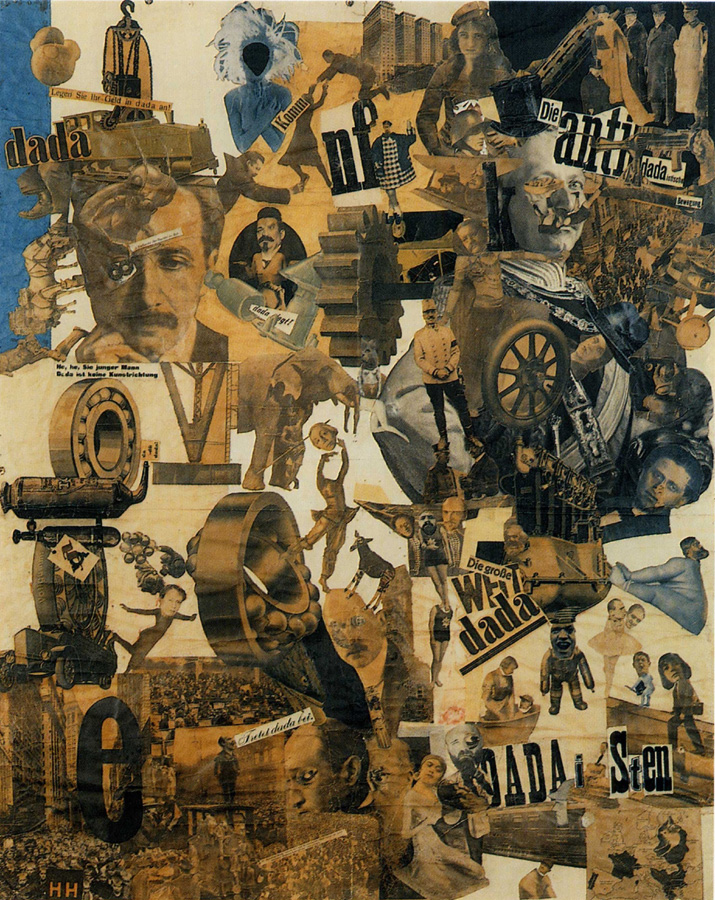For each of my four collages, I chose to implement them with as little elements as possible. All four consisted of three different cutouts from various magazines and books, particularly from ones that focused upon fine and contemporary art. I sought to implement both geometrical and more obtuse forms together, to create a sense of conflict from the two different styles.
I drew a great deal of inspiration from Dada artists, in particular that of Hannah Hoch. Her work within the Dada movement of the early 19th century was paramount in terms of how I went about constructing the four pieces. Within much of her work, she used minimal elements taken from a whole array of sources, creating often absurd yet readable compositions. I sought to follow in suite, incorporating as few components as possible yet muddying the compositions further. While there are pieces of hers such as, Cut with the kitchen knife Dad through the beer-belly of the Weimar Republic, 1919, that had an almost cacophonous tone due to the pure chaos embodied, this intensity is often scaled back in her more minimalist work. On one hand, I truly enjoy the intentional choice of less elements such as within her piece, German Girl, 1930, yet there often feels to be a great deal of unused space and a hard edged border. While on the other hand, in the aforementioned piece Cut with the Kitchen Knife, while there is a sense of chaos it at times feels disjointed and less interwoven such as components within German Girl.
I sought to draw inspiration from this dichotomy by taking a more stripped back approach yet through the use of samples from sources that are texturally rich and diverse, to create a sense of submersion for the viewer. In addition, through diving deeper into her overall body of work, her use of negative space in many of her portraiture pieces was often large and noticeable. This in turn often left the subject centered within the composition, with a great deal of the page the cutouts were glued upon still visible by the viewer. In turn, I thought it would be amusing to create a greater sense of claustrophobia by rejecting any use of the paper, as it would separate the elements. In turn, this had the effect of all of the cutouts overlapping upon one another. By cutting the rest of the paper away this led to the overall shape being abnormal which in turn did not align to Hoch’s rectangular frame that she often implemented.
A particular difficulty that I found within constructing these pieces was deciding upon which cutouts to choose from and to implement within the different compositions. Being that there was only three elements within each, this lead to a greater deal deliberating and deciding upon which would fit best. With restrictions gave a greater sense of thought and contemplation.

https://www.artbasel.com/catalog/artwork/71260/Hannah-H%C3%B6ch-Over-the-Water

https://www.artbasel.com/catalog/artwork/67415/Hannah-H%C3%B6ch-Hochfinanz

http://www.rachelwithers.com/hannah-hoch/

https://en.wikipedia.org/wiki/Hannah_H%C3%B6ch#/media/File:Hoch-Cut_With_the_Kitchen_Knife.jpg

https://arthistoryproject.com/artists/hannah-hoch/german-girl/
sources:
Withers, Rachel. “Hannah Höch.” Rachel Withers, ArtForum, 2014, www.rachelwithers.com/hannah-hoch/.
Hudson, Mark. “Hannah Hoch: The Woman That Art History Forgot.” The Telegraph, Telegraph Media Group, 14 Jan. 2014, www.telegraph.co.uk/culture/art/10545071/Hannah-Hoch-The-woman-that-art-history-forgot.html.
No comments:
Post a Comment